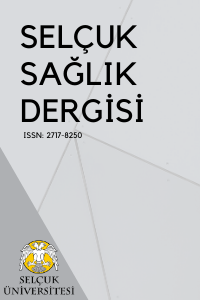BİTERMAL VE MONOTERMAL KALORİK TEST SONUÇLARININ FARKLI PAREZİ ORANLARI REFERANS ALINDIĞINDAKİ ETKİNLİĞİNİN KARŞILAŞTIRILMASI
Amaç: Vestibüler sistemin değerlendirilmesinde videonistagmografi (VNG) ile yapılan testler sıklıkla kullanılmaktadır. Bu testlerden biri de kalorik testtir. Kalorik test rutinde binaural ve bitermal (sıcak ve soğuk uyaranlar) olarak yapılmaktadır. 25-35 dakika kadar süren kalorik test esnasında kalorik uyaran ile indüklenen bulantı ve vertigo oluşabilir. Bu durum hasta konforunu olumsuz yönde etkileyebilmektedir. Bu sebeple çalışmamızın amacı, monotermal kalorik test sonuçları ile bitermal kalorik test sonuçlarının farklı cut-off değerlerinde uyumuna bakarak; monotermal kalorik testin zaman ve hasta konforunun arttırılması için klinikte uygulanabilirliğinin değerlendirilmesi olarak planlanmıştır.
Gereç ve Yöntemler: Çalışma, retrospektif olarak planlandı. 303 katılımcı verisi kullanılarak, bitermal test sonucuna göre %25 ve %20 parezi oranları altın standartlar olarak varsayıldı. Farklı parezi oranlarının altın standartlara göre sensivite, spesifite ve genel doğruluk oranları hesaplandı. Her bir değişkenin altın standart ile uyumu Kappa katsayısı ile incelendi. Tüm analizler için istatistiksel anlamlılık değeri p
Anahtar Kelimeler:
Bitermal, Kalorik test, Monotermal, Parezi
COMPARISON OF THE EFFECT OF BIOTHERMAL AND MONOTHERMAL QUALITY TEST RESULTS WHEN DIFFERENT PARESIS RATES ARE REFERENCED
___
- Agrawal Y, Carey JP, Della Santina CC, Schubert MC, Minor LB. Disorders of balance and vestibular function in US adults: data from the National Health and Nutrition Examination Survey, 2001-2004. Arch Intern Med 2009;169:938-44. [Erratum in Arch Intern Med 2009;169:1419.].
- Barber, H. O., Wright, G., Demanuele, F. (1971). The hot caloric test as a clinical screening device. Arch Otolaryngol, 94, 335–337.
- Becker GD. The screening value of monothermal caloric tests. Laryngoscope 1979;89:311-4.
- Bernstein L. Simplification of clinical caloric test. Arch Otolaryngol 1965;81:347-9.
- Bush, M. L., Bingcang, C. M., Chang, E. T., et al. (2013). Hot or cold? Is monothermal caloric testing useful and cost-effective? Ann Otol RhinolLaryngol, 122, 412–416.
- Cunha, L. C., Felipe, L., Carvalho, S. A., et al. (2010). Validity of the monothermal caloric testing when compared to bithermal stimulation. Pro Fono, 22, 67–70.
- Enticott, J. C., Dowell, R. C., O’Leary, S. J. (2003). A comparison of the monothermal and bithermal caloric tests. J Vestib Res, 13, 113–119.
- Hart CWJ. The value of the hot caloric test. Laryngoscope 1965;75:302-15.
- Jongkees, L.B.W., and Philipszoon, A.J., (1964). Electronystagmography. Acta Otolaryngol (Suppl. 189).
- Keith RW, Pensak ML, Katbamna B. Prediction of bithermal caloric response from monothermal stimulation. Otolaryngol Head Neck Surg 1991;104:499-502.
- Lightfoot, G., Barker, F., Belcher, K., et al. (2009). The derivation of optimum criteria for use in the monothermal caloric screening test. Ear Hear, 30, 54–62.
- Murnane OD, Akin FW, Lynn SG, Cyr DG. Monothermal caloric screening test performance: a relative operating characteristic curve analysis. Ear Hear. 2009 Jun;30(3):313-9. doi: 10.1097/AUD.0b013e31819c3ec7. PMID: 19322091.
- Ranganathan P, Pramesh CS, Aggarwal R. Common pitfalls in statistical analysis: Measures of agreement. Perspect Clin Res 2017;8:187-91, doi: 0.4103/picr.PICR_123_17.
- Shupak, A., Kaminer, M., Gilbey, P., et al. (2010). Monothermal caloric testing in the screening of vestibular function. Aviat Space Environ Med, 81, 369–374.
- Yayın Aralığı: Yılda 3 Sayı
- Başlangıç: 2020
- Yayıncı: Selçuk Üniversitesi
Sayıdaki Diğer Makaleler
Mehmet Kadir ERCAN, Meltem TULĞAR
PANİK ATAK VE PANİK BOZUKLUĞUNDA BİLİŞSEL HATALAR
Mehmet Hamdi ÖRÜM, Gökçe MART, Mehmet MART
COVID-19 TEDAVİSİNDE MİKROBİYOTANIN ÖNEMİ
HEMŞİRELİK ÖĞRENCİLERİNİN ERKEN YAŞ EVLİLİKLERE İLİŞKİN GÖRÜŞLERİNİN BELİRLENMESİ
Gülfiya BEBİTOVA, Tuba GÜNER EMÜL
COVID-19 PANDEMİSİ KONUSUNDA TÜRKİYE’DE YAPILAN LİSANSÜSTÜ TEZLER ÜZERİNE BİR DEĞERLENDİRME
